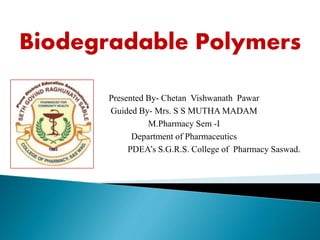Biodegradable Polymers
•Download as PPTX, PDF•
48 likes•13,105 views
This document discusses biodegradable polymers. It defines biodegradable polymers as polymers that break down into biologically acceptable molecules via normal metabolic pathways. The document classifies biodegradable polymers as natural or synthetic and lists examples of each. It also discusses the ideal characteristics, mechanisms of degradation, factors affecting biodegradation, and applications of biodegradable polymers.
Report
Share
Report
Share

Recommended
More Related Content
What's hot
What's hot (20)
Similar to Biodegradable Polymers
Similar to Biodegradable Polymers (20)
Biodegradable polymers for controlled release & Hydrogel classification,...

Biodegradable polymers for controlled release & Hydrogel classification,...
Polymers Used In Pharmaceutical dosage delivery systems

Polymers Used In Pharmaceutical dosage delivery systems
Recently uploaded
Recently uploaded (20)
THE IMPORTANCE OF MARTIAN ATMOSPHERE SAMPLE RETURN.

THE IMPORTANCE OF MARTIAN ATMOSPHERE SAMPLE RETURN.
FAIRSpectra - Towards a common data file format for SIMS images

FAIRSpectra - Towards a common data file format for SIMS images
PRESENTATION ABOUT PRINCIPLE OF COSMATIC EVALUATION

PRESENTATION ABOUT PRINCIPLE OF COSMATIC EVALUATION
GLOBAL AND LOCAL SCENARIO OF FOOD AND NUTRITION.pptx

GLOBAL AND LOCAL SCENARIO OF FOOD AND NUTRITION.pptx
Topography and sediments of the floor of the Bay of Bengal

Topography and sediments of the floor of the Bay of Bengal
Cancer cell metabolism: special Reference to Lactate Pathway

Cancer cell metabolism: special Reference to Lactate Pathway
ESR_factors_affect-clinic significance-Pathysiology.pptx

ESR_factors_affect-clinic significance-Pathysiology.pptx
biotech-regenration of plants, pharmaceutical applications.pptx

biotech-regenration of plants, pharmaceutical applications.pptx
Gliese 12 b, a temperate Earth-sized planet at 12 parsecs discovered with TES...

Gliese 12 b, a temperate Earth-sized planet at 12 parsecs discovered with TES...
Biodegradable Polymers
- 1. Presented By- Chetan Vishwanath Pawar Guided By- Mrs. S S MUTHA MADAM M.Pharmacy Sem -I Department of Pharmaceutics PDEA’s S.G.R.S. College of Pharmacy Saswad. Biodegradable Polymers
- 2. INTRODUCTION Ideal characteristics Classification Mechanism of Degradation FACTORS AFFECTING BIODEGRADATION OF POLYMERS ADVANTAGES APPLICATIONS OF BIODEGRADABLE POLYMERS
- 3. Polymers are very large molecules made when hundreds of monomers join together to form long chains Polymers are complex and giant molecules usually with carbons building the backbone, different from low molecular weight compounds. The small individual repeating units/moleules are known as monomers(means single part).
- 4. Linear ◦ High Density Polyethylene (HDPE), PVC, Nylon, Cotton Branched ◦ Low Density - Polyethylene (LDPE) Cross-linked ◦ Rubber Network ◦ Kevlar, Epoxy
- 5. Biodegradable polymers are defined as polymers comprised of monomers linked to one another through functional groups and have unstable links in the backbone. They are broken down into biologically acceptable molecules that are metabolized and removed from the body via normal metabolic pathways.
- 6. They slowly disappear from the site of administration in response to a chemical reaction such as hydrolysis.
- 7. Ideal characteristics of Biodegradable polymer:- They should be biocompatible-(shape, surface, and leachable) They should be bio absorbable-(degradability profile, reabsorption of degradation products.) They should be bi functional-(physical, mechanical and biological). They should be stable-(processing, sterilization and storage).
- 8. Biodegradable polymers can be classified in two on the basis of their sources: •Natural polymers: Proteins: Example: Albumin, Collagen, Gelatin etc. Polysaccharides: Example: Sodium alginate, Chitin, Chitosan, Cellulose, Dextran, Insulin, Starch etc. •Synthetic polymers: Aliphatic polyesters: Example: Poly-Glycolic Acid (PGA), Poly Lactic Acid (PLA), Poly-Hydroxy Butyrate (PHB), Poly-β- Malic Acid (PMA) etc. Poly Phospho Esters Poly Anhydrides Poly Phosphazenes Pseudo Amino Acids Poly Ortho Esters
- 9. The use of natural biodegradable polymers to deliver drugs continues to be an area of active research despite the advent of synthetic biodegradable polymers. Natural polymers remain attractive primarily because, They are an attractive class of biodegradable polymers. They are derived from natural sources. They are easily available. They are relatively cheap. They qualify for a number of chemical modifications. They can be a protein or a polysaccharide in chemical origin.
- 10. Most attractive class of polymers. Biocompatible and versatile in terms of physical, chemical and biological properties. Stability of the polymer can be increased as they are chemically synthesized.
- 11. Polymer degradation is a change in the properties – tensile strength, colour, shape, etc of a polymer or polymer based product under the influence of one or more environmental factors such as heat, light or chemicals. The term 'biodegradation' is limited to the description of chemical processes (chemical changes that alter either the molecular weight or solubility of the polymer) ‘Bioerosion' may be restricted to refer to physical processes that results in weight loss of a polymer device with respect to time.
- 12. • BIODEGRADATION HYDROLYSIS SURFACE EROSION ENZYMATIC DEGRADATION COMBINATION BULK EROSION
- 13. 1) Bulk erosion Degradation takes place throughout the whole of the sample. Ingress of water is faster than the rate of degradation Eg : Polylactic acid (PLA) Polyglycolic acid (PGA) 2) Surface erosion ◦ Sample is eroded from the surface. ◦ Mass loss is faster than the ingress of water into the bulk Eg:Polyanhydrides polyorthoesters
- 14. CLEAVAGE OF CROSSLINKS TRANSFORMATION OF SIDE CHAINS CLEAVAGE OF BACKBONE Chemical or enzymatic degradation – It is mediated by water, enzymes, microorganisms.
- 15. Morphological factors • Shape & size • Variation of diffusion coefficient and mechanical stresses Chemical factors • Chemical structure & composition • Presence of ionic group and configuration structure • Molecular weight and presence of low molecular weight compounds Physical factors • Processing condition • Sterilization process
- 16. • Localized delivery of drug • Sustained delivery of drug • Stabilization of drug • Decrease in dosing frequency • Reduce side effects • Improved patient compliance • Controllable degradation rate
- 17. Polymer system for gene therapy. Biodegradable polymer for ocular, tissue engineering, vascular, orthopedic, skin adhesive & surgical glues. Bio degradable drug system for therapeutic agents such as anti tumor, antipsychotic agent, anti-inflammatory agent. Many biomaterials, especially heart valve replacements and blood vessels, are made of polymers like Dacron, Teflon and polyurethane.
- 18. Biopol . Polycaprolactone Polylactic Acids Polyglycolic Acids Polydioxane
